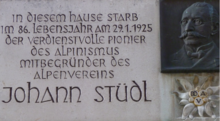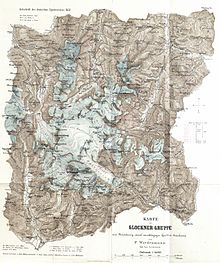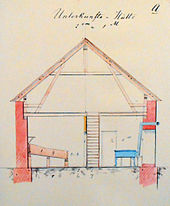Johann Stüdl


Johann Stüdl (born June 27, 1839 in Prague , † January 29, 1925 in Salzburg ) was a Prague merchant and promoter of alpinism in Austria .
Life
Johann Stüdl was born on June 27, 1839 as the first child of a Prague merchant family. Contrary to his father's advice, his son, who was interested in natural sciences, began studying chemistry in 1856, first in Prague and later at the Dresden Polytechnic . However, he gave up the study when his father died young and he, in Prague, the trade in wine and groceries had to continue.
Despite the heavy business demands over decades, Stüdl was able to devote himself completely to the Alpine cause , both practically, as an alpinist, and theoretically, as an Alpine writer and organizer.
Johann Stüdl married in 1872. With his wife he had two daughters and a son, Max.
In 1919, at the age of 81, Stüdl, as an old champion for Germanism , was forced to leave his hometown, Prague. He moved to his son and his family in the city of Salzburg, where Max († November 4, 1921) acquired the Goldene Pear Inn ( Judengasse 1 ).
In the last years of his life, Stüdl developed a lively activity in the Salzburg section and was promoted to the Söldenhütte ( Tennengebirge ) just over six months before his death .
Cared for by his daughter-in-law for the last years, imperial councilor Johann Stüdl died on January 29, 1925 in Salzburg. On January 31, 1925, he was buried in the Salzburg municipal cemetery at the side of his son and relatives who had been transferred from Prague.
As recorded in an obituary, Johann Stüdl was a man with a tried and tested liberal disposition who had taken a lifelong position against politics being dragged into mountaineering and who had condemned the hateful actions against the former Donauland section of the Alpine Club in word and writing . On the exclusion of the Donauland section from the Alpine Club in 1924, Stüdl said:
- “The blatant injustice that the main committee, in its foolish fear of the terror of destructive elements and the misguided, agitated, insufficiently informed sections on 'Donauland' are preparing to commit, will not bring peace to the Alpine Association, but the curse of evil . "
Services
Johann Stüdl played a key role in developing the Glockner and Venediger groups in the Eastern Alps for tourism . When he and his brother Franz came to Kals am Großglockner for the first time in 1867 to climb the highest mountain in Austria, he noticed that the people of Kals were looking for a sponsor for their project to develop a new route to the Großglockner over the southwest ridge . Stüdl not only invested in the construction of a climbing system with iron pins and ropes , but also financed the construction of the Stüdlhütte named after him at the foot of the south-west ridge in 1868 , the first refuge in the Central Eastern Alps. At the beginning of the 20th century, the name Stüdlgrat, which is still used today, was adopted for the southwest ridge in honor of Stüdl .
In addition to his activities in the area around the Großglockner, he also initiated or financed the construction of several other shelters in the Alpine region. These include the Prager Hütte and the Clarahütte (named after the wife of a wine merchant from Prague he knows) in the Großvenediger area , as well as the Glorerhütte on the Großglockner and the Payerhütte on the Ortler .
At the suggestion of Pastor Franz Senn from Vent in the Ötztal, Johann Stüdl founded the first mountain guide association in the Eastern Alps in Kals am Großglockner in 1869 and thus laid the foundation for today's organized mountain guide system in Austria. He was also a founding member of the German Alpine Club (DAV) and chairman of the Prague section of the DAV for 50 years .
First ascents
Stüdl is the first to climb the Schneewinkelkopf , the Hohe Riffl , the Hinteren Bratschenkopf , the Klockerin and the Großer Bärenkopf in the Glockner group. He also looked for a long time to descend from the summit of the Großglockner directly to the Pasterzen glacier , but couldn't find one. Instead, a friend of Stüdl's, Karl Hofmann from Munich , succeeded in doing this in 1870 .
Publications
-
Ascent of the Wildspitze . - Ascent of the Zuckerhütl . - From the Habichtspitze through the Mischbachthal to Neustift .
In: Yearbook of the Austrian Alpine Association . Volume 4.1868. Gerold, Vienna 1868, OBV . - Ascent of the white ball . In: Yearbook of the Austrian Alpine Association . Volume 5.1869. Gerold, Vienna 1869, OBV .
- The lower Oedenwinkelscharte. In: Journal of the German Alpine Club , year 1869–70, (Volume I), pp. 117–139. (Online at ALO ).
- Kals. In: Journal of the German Alpine Club , year 1871, (Volume II), pp. 333–351. (Online at ALO ).
- The Kalser Thörl. In: Journal of the German Alpine Club , year 1871, (Volume II), pp. 352–355. (Online at ALO ).
- Excursions in 1868. In: Journal of the German Alpine Club , year 1871, (Volume II), pp. 356–362. (Online at ALO ).
- The Fuscherthal. In: Journal of the German Alpine Club , year 1871, (Volume II), pp. 376–387. (Online at ALO ).
- Via the Fuscherkarscharte to Heiligenblut. In: Journal of the German Alpine Club , year 1871, (Volume II), pp. 363–375. (Online at ALO ).
- The Berger Thörl. In: Journal of the German Alpine Club , year 1871, (Volume II), pp. 388–393. (Online at ALO ).
- The Hohenburg. In: Journal of the German Alpine Club , year 1871, (Volume II), pp. 450–452. (Online at ALO ).
- Ascent of the Great Wiesbachhorn from Kapruner Thale. In: Journal of the German Alpine Club , year 1871, (Volume II), pp. 453–457. (Online at ALO ).
- Glockerin, Big and Small Bear Head. In: Journal of the German Alpine Club , year 1871, (Volume II), pp. 458–465. (Online at ALO ).
- The Schwarzkopf. In: Journal of the German Alpine Club , year 1871, (Volume II), pp. 466–471. (Online at ALO ).
- From Ferleiten to Kals. In: Journal of the German Alpine Club , year 1871, (Volume II), pp. 472–473. (Online at ALO ).
- An interesting sheet. In: Journal of the German Alpine Association / Journal of the German and (the) Austrian Alpine Association , year 1877, (Volume VIII), pp. 136–137. (Online at ANNO ). .
- About hut construction. With hut plans (panel X). In: Journal of the German Alpine Association / Journal of the German and (the) Austrian Alpine Association , year 1877, (Volume VIII), pp. 169–191. (Online at ANNO ). . - Hut plans (panel X) .
- About provisions depots. In: Communications of the German and Austrian Alpine Club , year 1881, (Volume VII), p. 152 middle. (Online at ALO ).
- A memorial sheet for Karl Hofmann. In: Mitteilungen des Deutschen und Österreichischen Alpenverein , born in 1914, (Volume XL), p. 232 ff. (Online at ALO ).
- Prof. Dr. Theodor Petersen †. In: Communications from the German and Austrian Alpine Club , born in 1919, (Volume XLV), p. 1 f. (Online at ALO ).
Together with Eduard Richter - hikes in the Venediger group :
- I. The Gross-Venediger from Gschlöss. In: Journal of the German and Austrian Alpine Association , year 1872, (Volume III), pp. 276–281. (Online at ALO ).
- II. Schlieferspitze. In: Journal of the German and Austrian Alpine Club , year 1872, (Volume III), pp. 281–286. (Online at ALO ).
- III. Order of leadership in Prägraten. In: Journal of the German and Austrian Alpine Club , year 1872, (Volume III), pp. 286–291. (Online at ALO ).
- IV. Umbalthal and Dreiherrenspitze. In: Journal of the German and Austrian Alpine Club , year 1872, (Volume III), pp. 292–299. (Online at ALO ).
- V. Attempt on the Daberspitze and ascent of the Röthspitze (Welitz). In: Journal of the German and Austrian Alpine Club , year 1872, (Volume III), pp. 299–307. (Online at ALO ).
- VI. Ascent of the Hochgall. In: Journal of the German and Austrian Alpine Club , year 1872, (Volume III), pp. 307–316. (Online at ALO ).
Awards, honors
- Papal New Year's Order
- Order of St. Michael
- Order of the Red Eagle
- Knight's Cross of the Franz Joseph Order
- Honorary citizenships of the Tyrolean and South Tyrolean communities of Kals and Matsch
- Commemorative plaque in recognition of achievements for the Suldental (August 22, 1897)
- kuk purveyor to the court
literature
- Ch. Chancellor: Stüdl Johann. In: Austrian Biographical Lexicon 1815–1950 (ÖBL). Volume 13, Verlag der Österreichischen Akademie der Wissenschaften, Vienna 2007–2010, ISBN 978-3-7001-6963-5 , p. 442.
- Johannes Emmer: The road and hut buildings. In: History of the German and Austrian Alpine Club. In: Journal of the German and Austrian Alpine Association , year 1894, (Volume XXV), pp. 230–351. (Online at ANNO ). .
- A (loys) Dreyer: Johann Stüdl. A commemorative sheet for his 70th birthday (June 27, 1919). In: Communications of the German and Austrian Alpine Club , born in 1909, (Volume XXXV), p. 142 f. (Online at ALO ).
- A (loys) Dreyer: Johann Stüdl. On his 80th birthday (June 27, 1919). In: Announcements of the German and Austrian Alpine Club , born in 1919, (Volume XLV), p. 72 f. (Online at ALO ).
- (Obituary :) Johannes Emmer: Johann Stüdl. In: Journal of the German Alpine Association / Journal of the German and (the) Austrian Alpine Association , year 1925, (Volume LVI), pp. 1–8. (Online at ANNO ). .
- Johann Stüdl † - Johann Stüdl's curriculum vitae. - Stüdl as an alpinist. - The alpine writer. - The organizer. - Stüdl's last days and last trip. In: "Donauland-Nachrichten" . (Formerly: News from the “Donauland” section of the German and Austrian Alpine Association ), born in 1925, No. 43, pp. 24–28. (Online at ANNO) .
- Johannes Emmer: Johann Stüdl †. as well as at Stüdl's grave . In: Mitteilungen des Deutschen und Österreichischer Alpenverein , born in 1925, (Volume LI), p. 29 and 30. (Online at ALO ).
- Heinrich Hackel: At Johann Stüdl's funeral. In: Mitteilungen des Deutschen und Österreichischer Alpenverein , born in 1925, (Volume LI), p. 45. (Online at ALO ).
- R (aimund) v (on) Klebelsberg : Johann Stüdl † . In: The Sciliar. Monthly magazine for South Tyrolean regional studies . Volume 6.1925. Publishing house Athesia, Bozen 1925, p. 37–, OBV .
- Maria Hackel: Father Stüdl's last ascent. In: Mitteilungen des Deutschen und Österreichischer Alpenverein , born in 1925, (Volume LI), p. 120 ff. (Online at ALO ).
- Gerold Benedikter (Red.), Johann Stüdl: Kals, under the spell of the Großglockner - published on the 60th anniversary of Johann Stüdl's death and the first ascent of the Großglockner from Kals 130 years ago . 2nd Edition. OeAV documents, volume 1. Austrian Alpine Association, Innsbruck 1988, OBV .
- Margarete Rachbauer: Johann Stuedl and the development of the Glockner group with special consideration of geographical aspects . Housework (from geography). University of Salzburg, Salzburg 1988, OBV .
- Wolfgang Pusch, Leo Baumgartner: Grossglockner . 4th edition. Bergverlag Rother , Munich 2007, ISBN 3-7633-7509-0 .
Web links
- Gerhard Schirmer: Johann Stüdl - The Glockner King . In: bergnews.com , accessed January 18, 2011 - biography.
- Personal folder on Johann Stüdl (I) (PDF) in the historical Alpine archive of the Alpine clubs in Germany, Austria and South Tyrol (temporarily offline)
- Personal folder on Johann Stüdl (II) (PDF) in the historical Alpine archive of the Alpine clubs in Germany, Austria and South Tyrol (temporarily offline)
- Ernst Platz : Johann Stüdl, based on a chalk drawing, 1925. In: Journal of the German Alpine Association / Journal of the German and (the) Austrian Alpine Association , year 1925, (Volume LVI), p. 1, title page . (Online at ANNO ). .
- Johann Stüdl died. In: Prager Tagblatt , January 30, 1925, p. 4, bottom right. (Online at ANNO ). .
- Daily news. (...) Hans Stüdl †. In: Wiener Zeitung , January 30, 1925, p. 7, bottom center. (Online at ANNO ). .
- Josef Braunstein: Johann Stüdl died. In: Der Naturfreund , born 1925, XXIX. Volume, p. 13. (Online at ANNO ). .
- Works by and about Johann Stüdl in the German Digital Library
Individual evidence
- ↑ a b c d e f g Johann Stüdl's curriculum vitae.
- ↑ a b Emmer: At Stüdl's grave .
- ↑ Friederike Zaisberger , Reinhard R. Heinisch (ed.): Life beyond death ... Prominent people in the Salzburg municipal cemetery (= messages from the Society for Salzburg Regional Studies, supplementary volume 23). Society for Salzburg Regional Studies, Salzburg 2006, OBV , p. 312.
- ↑ Max Stüdl †. In: Mitteilungen des Deutschen und Österreichischer Alpenverein , born in 1921, (Volume XLVII), p. 89, top right. (Online at ALO ).
- ↑ Hackel: Father Stüdl's last ascent , p. 120.
- ^ Death of the outstanding alpinist Johann Stüdl. In: Neue Freie Presse , Morgenblatt, No. 21689/1925, January 30, 1925, p. 6 middle. (Online at ANNO ). .
- ↑ Martin Achrainer, "So, now we are all to ourselves!" Anti-Semitism in the Alpine Association. , in: Hanno Loewy, Gerhard Milchram (eds.), “Did you see my Alps?” A Jewish relationship story, exhibition catalog, Vienna 2009, pp. 288–317, there p. 308
- ^ The Stüdl celebration in Sulden. In: Communications of the German and Austrian Alpine Club , year 1897, (Volume XXIII), p. 216 f. (Online at ALO ).
- ^ Dreyer: Johann Stüdl. A memorial sheet for his 70th birthday , p. 143.
Remarks
- ↑ She dies many years before her husband.
- ↑ a b Publication reference in: Emmer: Johann Stüdl. (...) The alpine writer.
- ↑ a b c class not known.
| personal data | |
|---|---|
| SURNAME | Stüdl, Johann |
| BRIEF DESCRIPTION | Prague merchant and promoter of mountaineering |
| DATE OF BIRTH | June 27, 1839 |
| PLACE OF BIRTH | Prague |
| DATE OF DEATH | January 29, 1925 |
| Place of death | Salzburg |



